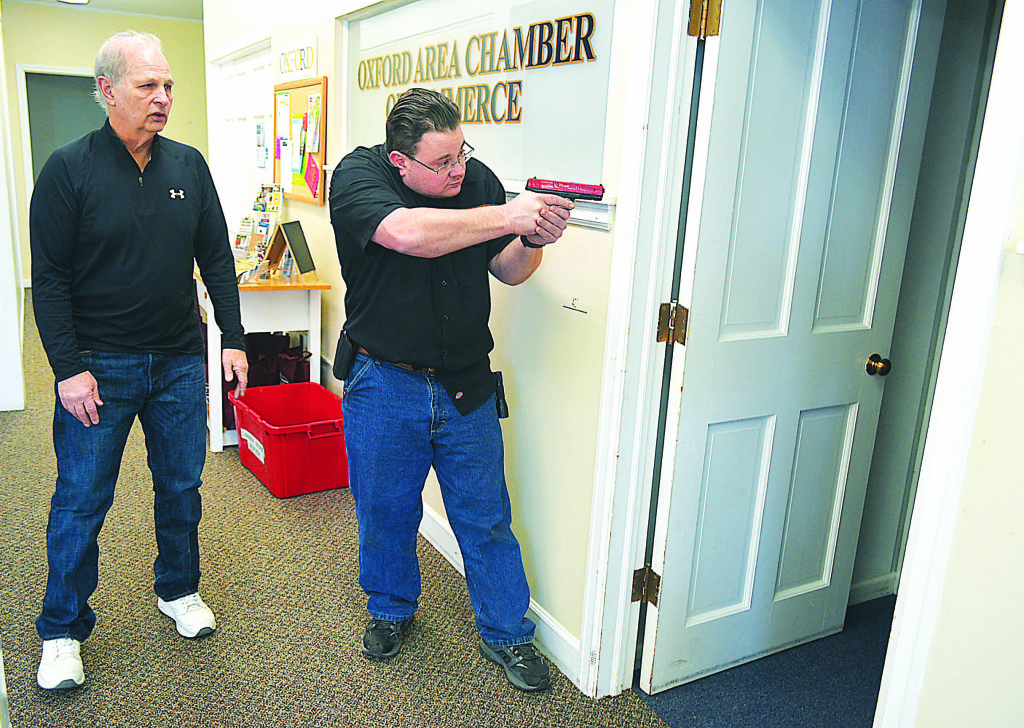
If there’s ever an active shooter situation in Oxford, the village police department wants its officers prepared to deal with it and hopefully, save as many lives as possible.
To that end, some officers recently underwent tactical training under Reserve Officer Gene Faermark, one of three firearms and tactics instructors for the agency.
Faermark previously completed the Active Shooter Threat Training Program (ASTTP) offered by the Federal Law Enforcement Training Centers (FLETC).
“It’s available to anybody in law enforcement,” he said.
This four-day, hands-on, intensive program is designed to equip law enforcement officers and agents with the knowledge and skills needed to successfully end an active threat event, according to the FLETC website.
“It’s a complete program taught by some of the best instructors in the world,” said Faermark, who’s been with the village department since 2004. “I’ve been through it twice.”
Faermark took the course once in Alexandria, Virginia in 2016 and again, in Lake Orion last year. It was all paid for by the federal government.
“This training is really not about a team response, it’s about an individual officer response,” Faermark said.
He explained that traditionally, whenever an officer was the first one to arrive at an active shooter scene, he or she was supposed to wait for other officers to show up.
What the ASTTP does is train that first officer to, “without hesitation,” enter the building and attempt to “eliminate the threat” as quickly as possible.
Providing officers with specific techniques to utilize in these situations gives them a “mental edge,” according to Faermark.
“An untrained officer might have doubts – ‘Should I go in? Should I wait? I don’t know what to do,’” he said. “Our officers are trained to go in immediately and deal with the problem. They have the knowledge of how to deal with the problem, so that they have confidence (to do it).”
Faermark believes it’s important that local cops undergo this type of training because “no one will get to a scene in our community faster than the officer that’s out on patrol.”
“The faster your response, the fewer people are going to get shot or killed,” he said.
Once inside the building, officers are taught to employ “limited penetration” tactics as they conduct a methodical room-to-room search.
“This teaches him how to safely enter a room during the search, so that he can gather intelligence without getting shot himself,” Faermark said. “He doesn’t just jump into a room.”
Faermark said officers are trained to continue searching until they hear shots. When that happens, “he immediately starts moving as quickly as he can to the source of the fire to eliminate the threat as quickly as possible.”
As part of the ASTTP, officers also learn tactical medical procedures so they can treat themselves if they get wounded.
When an officer enters an active shooter scene, he or she carries a “go bag” containing things such as ammunition, flashlights and an Individual First-Aid Kit (IFAK). Included in the IFAK are tourniquets, chest seals and gauze treated with hemostatic agents, all of which are designed to stop bleeding.
“The leading cause of battlefield death is blood loss,” Faermark said. “The first and most important thing you can do is contain and eliminate blood loss. It’s all about stopping blood loss until better help arrives on scene.”
Faermark plans to conduct another round of active shooter threat training with village officers either this month or next.
“It’s all about saving lives,” he said. “That’s what we signed on for.”

Leave a Reply